Like Castlevania, Kid Icarus tells a story through its environmental design. Castlevania‘s story, I think, is relayed more effectively via its visuals, but Kid Icarus‘ narrative actually fits better with the progression of its play mechanics.
In brief, the gorgon Medusa has deposed the goddess of light, Palutena, imprisoning both the goddess and her subjects while taking possession of the Sky Palace. The game begins with the youngest and humblest of Palutena’s warriors, Pit, escaping from a prison deep underground and fighting his way to the surface.
Fittingly, the early stages of the game are far and away the most difficult. World 1-1 introduces most of the tricks and traits of Kid Icarus straight away, yet the player is armed with only a miserable short-range bow and pitiful little arrows. My suspicion is that the vast majority of people who play Kid Icarus never even make it to World 2-1, which is a shame because the game becomes hilariously easy once you emerge from the underworld and reach the surface.
But here, in the stygian depths, it’s a tough fight from the word go. Pit begins with a mere seven points of health, and shops and bonuses prove few and far between.
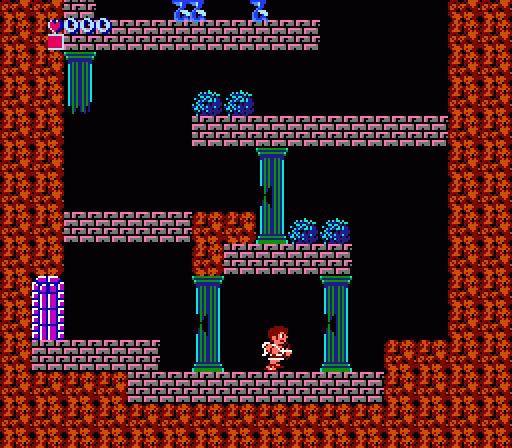
Not unlike Mario in Donkey Kong, Pit starts the adventure at the lower left of the screen with platforms and hazards above. You can move only right, and after that only right and up. To drive the point home that your goal lies upward, a formation of serpents called Shemun drops down from above as you advance. They shuffle their way toward Pit and plunge from any edge they encounter. Right away the game presents you with essential information: Pit can leap three blocks high, fire on foes at short range, and shoot in three directions (left, right, up) much like Samus Aran.
Since the Shemum drop in on you as they march down on you, Pit has the opportunity to make use of his full array of his initial skills (which admittedly aren’t many). You can begin to advance forward between waves of Shemum — only four appear on screen at a time — and pop them one at a time as you jog forward and upward.
After you scroll up a screen or so, the path twists to the right, forcing you off the side of the screen. This introduces one of the more unusual design mechanics of Kid Icarus: The vertical stages work a bit like Pac-Man, with wraparound tunneling on the sides of the screen. Rather than existing as finite boundaries, the edges of the screen simply send you to the opposite side of the screen. Both Pit and his enemies can pass back and forth in this manner (though only ground-based enemies do; flying monsters never stray past the edge of the screen). Projectiles, however, cannot. This means you can’t stand safely on one side of the screen and pluck enemies on the other edge, but it also means enemy projectiles can’t follow you around the wrap, so it works out greatly in your favor overall.
Before you come across the first screen warp, though, Pit encounters a small curiosity: A door built into the ledge beneath the platform warping over to the left of the screen. And inside the door is… nothing whatsoever. It’s an empty room. Weird, right? This room can potentially be of benefit to you once you’ve completed a playthrough of the game, but your first time it’s completely empty and pointless. It’s a strange design choice, and not a smart one. Rather than rewarding the player for indulging in the small amount of exploration Kid Icarus allows, you’re left wondering, what’s the point?
Shooting enemies causes hearts to appear. Weak enemies like Shemum leave small hearts, but in time you’ll find large full- and half-hearts as well. Their use isn’t immediately apparent (unlike in Zelda, they don’t refill your health), but they’re clearly important as they add to a running point tally at the top of the screen: One for small, five for half-sized large, 10 for full large. Interestingly, respawning enemies (again, like Shemum) won’t regenerate until you’ve collected all the hearts dropped by the previous group of that foe — presumably this has to do with technical limitations of the NES, but it adds a touch of strategy to the action as you can affect the timing of enemies to a certain degree based on how you collect hearts.
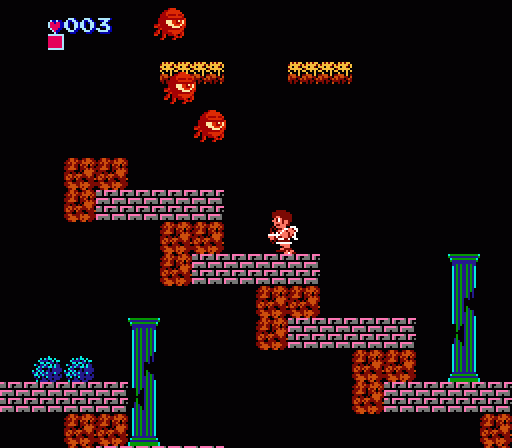
Once you wrap around from right to left and continue your ascent, a new form of enemy appears: Monoeyes, which fly in formations of four. Their flight path tends to describe something like a sideways figure 8, and they rarely pose any direct threat to Pit in this initial stage, preferring instead to lurk above and at the edge of Pit’s bow range. Occasionally, a Monoeye will split off from the pack (generally as a result of the player scrolling the screen) to harass Pit, but on the whole these guys mostly serve as a distraction from more immediate threats. However, they do drop half-sized large hearts, so there’s definitely value in shooting them (even if you won’t learn that value until later in the game).
Shortly after the Monoeyes debut, Pit encounters his first thin platforms. Thin platforms will almost certainly cause you no end of death, especially if you’re accustomed to contemporary game design conventions. Like platforms in many action games, Pit can drop through thin platforms by ducking… but the difference is that Pit need only duck, rather than ducking and jumping as in most games. At some point (probably many points, honestly), you will duck to avoid an enemy and drop through one of these platforms to your death.
Oh, right, that’s the other strange element of Kid Icarus’ design: The screen scrolls only in one direction. If you fall off the bottom edge of the screen, you die instantly… even if there was a platform a couple of pixels off the screen a moment ago. The one-way scrolling is reminiscent of Super Mario Bros., Adventure Island, and other early side-scrollers, but the addition of vertical movement in Kid Icarus makes for a weird mechanic. I suppose it’s meant to hearken back to the olden days, when falling from too high would kill a guy like Mario (née Jumpman) or the Spelunker, but it creates some grating logical inconsistencies. And when these flimsy, drop-through platforms appear, it can be downright infuriating.
Another new element appears here as well: A harp. Collecting the harp causes all enemy spawns to transform into mallets and slowly descend from the sky. You can gather up the mallets, though — like the the hearts — their specific purpose won’t be immediately apparent. But even if you don’t know the purpose of the mallets (or choose not to use them when the time comes), snagging the harp at least gives you a brief breather in which you’re safe from enemies.
Further up, the path splits. Since you can’t scroll back down, you have to commit to one path or the other blindly and hope for the best. The more obvious path, in the center of the screen doesn’t offer any special perks, but it does pit Pit against one of the toughest foes in the early portions of the game. The path to the right, on the other hand, loops off-screen and around to the left, leading up a narrow shaft largely safe from enemies (barring the odd drifting Monoeye) and leading to a doorway.
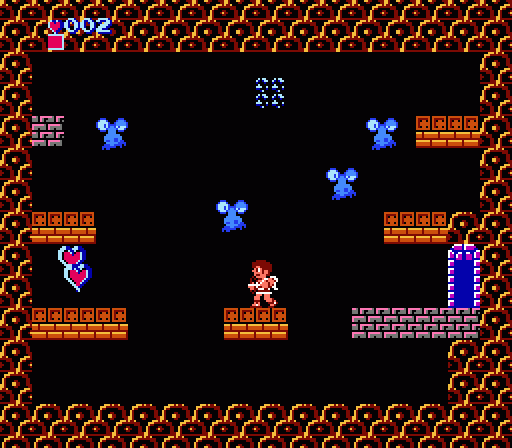
Unlike the last door, this one leads somewhere: Specifically, to a Specknose nest. These special rooms are totally optional, but they can be extremely beneficial. Specknoses are weak enemies that spawn in large numbers, each one sticking to its own set path. Individually, they’re no trouble at all, but when you’re in a room in which eight of them are zipping around in different orbits, they can be quite dangerous. But it’s worth taking them out, because each one is worth 10 hearts and a ton of experience. On the other hand, four hits and Pit is out of action.
On the plus side, shortly after the Specknose nest, you can snag a goblet, which restores a block of Pit’s health — at this point in the game, that’s all of it.
Regardless of which path you select, Pit will eventually have to contend with this stage’s most irritating foe, the Reaper. Though he doesn’t seem too threatening as he patrols slowly back and forth along a patch of ground, the Reaper freaks out if Pit crosses his line of sight, making a mad dash for the protagonist while screaming, his eyes bugging out. His shouts summon a formation of “Reapettes,” tiny flying Reapers that home in on Pit. They’re easy enough to take out, but they’ll keep spawning as long as the Reaper is alive… and since the Reaper takes 10 hits to fell at the beginning of the game, taking him out can be dangerous.
The second Reaper patrols outside another door, this one leading to a treasure room. Treasure rooms are welcome opportunities to grab some cash by shooting urns to reveal the prize inside, but they’re also a gamble — if you collect any treasures you’ve reveal, all unopened treasure pots vanish. One pot has the God of Poverty inside, and if you shoot that pot before revealing all the other treasures, you’ll lose everything. On the other hand, if you manage to save that one for last, you’ll get a rare or expensive treasure on top of everything else (including the credit card, which can’t be acquired any other way). It takes a few attempts to get the hang of it, but on the plus side the treasure rooms have a few reliable patterns that can be learned (or looked up online, or in the Nintendo Fun Club News) to give yourself a leg up.
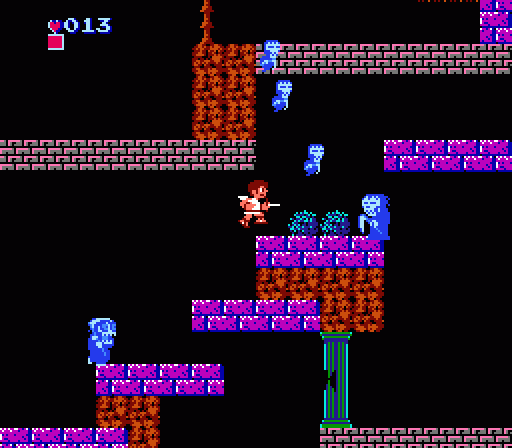
Beyond here are two more Reapers on patrol. They can be leapt over (carefully) if you don’t feel up to dealing with their shenanigans. On the other hand, the first one can be dealt with by jumping up and shooting it, then ducking across the screen-edge warp to avoid the Reapettes. The second one doesn’t allow for such easy flimflammery, as you have to scroll the platform that wraps across the edges in order to enter its line of sight. And as you’re dealing with it, a new enemy appears from above, Nettler.
Like a lot of enemies in this game, Nettler is no big deal on its own, but it can be irritating in combination with other foes. It shuffles forward awkwardly, but it kind of does the “drunken master” thing as its erratic lurching masks a canny ability to duck beneath Pit’s arrows. Two hits will take it out, but trying to hit it as it wobbles around, dropping from above into a fracas of Reaper and Reapettes, can be your undoing.
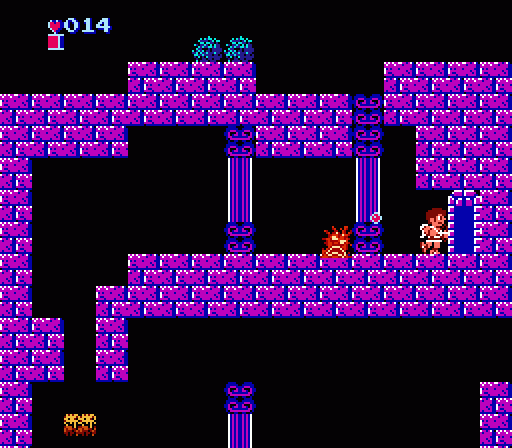
If you somehow manage to negotiate your way through this particular monster jam, World 1-1 has just one last nasty trick for you. A couple of McGoos will pop out of the ground as you scurry toward the exit, potentially bringing your quest to a short and sudden end. McGoos, by far, are the most infuriating enemies in the entire game. They rise out of the ground, giving a roughly one-second warning before popping up and firing a projectile at Pit. You can duck the bullet, but by the time it’s passed overhead, the McGoo will already have seeped back into the ground so it can pop up elsewhere for a second go-round. McGoos have the ability to appear on any kind of ground, often spawning directly under Pit’s feet, and later stages use McGoos to maddening effect.
Once you dodge this last cruelty, Pit clears the stage, tallies his points, and marches to the next level. Whenever you die in Kid Icarus, you’re send back to the beginning of the current stage (even if you’re within sight of the exit), so reaching the second stage serves as an essential checkpoint. If you can make it this far, the game ceases to be quite so insurmountable a challenge. The hardest part is over. (This is not how action games are meant to work.)
One thing that I have done is grind experience using the Reapettes in stage 1-1. Unlike to other enemies, these things have an unlimited supply (four at a time though). You can farm enough experience to max out Pit by the end of stage 1, if you have the patience.
The hardest part about this technique is not farming the Reapettes. It’s finishing the stage (which involves a few more precarious jumps) knowing that one slip-up will result in about an hour of monotonous grinding down the abyss.
Really fascinating end to this article. A veiled criticism in parentheses. It’s powerful, and has me excited both to read the next installment in this series and play Kid Icarus, which has long been a blind spot in my gaming history. Great work as always, Jeremy.
I actually think 1-2 is the most difficult stage in Kid Icarus. The enemies are about the same as 1-1 (though the Commylooses at the end make it tough), but the platforming is significantly more difficult. Meanwhile, Pit isn’t any stronger than in 1-1 (though he can get slightly stronger from the challenge room toward the end).
It was that level that I was stuck on for months as a kid (Maybe just one month, but that seemed like a lot at the time).
The difficulty in Kid Icarus is very front-loaded, but you can tell right from the start that this game’s gonna be a special kind of weird when Death goes crazy and calls in a squad of mini Deaths and you stumble upon the room full of Groucho Marx noses assaulting you.
Shame about the ratchet scrolling ascent, though. While I can tolerate it, I’m no fan of bottomless pits of eaten screen memory. That nonsense is why I only like Super Castlevania IV instead of loving it.
I do remember playing a little bit of this game when I was younger, but I never got very far. I usually died once or twice and then gave up. I just downloaded a copy onto my 3DS and am having more fun than I expected. I wonder if that is because I have patience now.
Thanks for doing Kid Icarus Jeremy, my favorite game of the NES era, either I was a sucker for punishment or I somehow psychically bonded with the game because I never had any trouble with the jumping mechanism once I figured which platforms worked and the sliding momentum. The ONLY thing I despised with every fiber of my being was Pluton (who you’ll get to) and of course the early monolith training when you had no powerup of energy extensions. Eggplant wizard was a fun enemy for me.